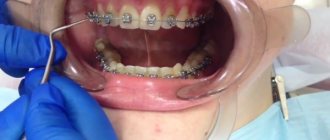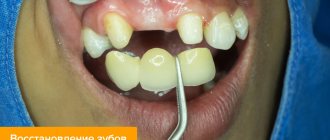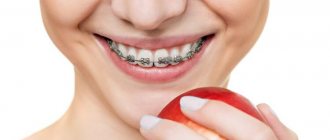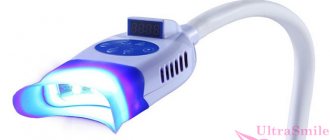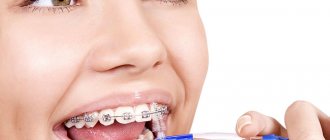In what cases is teeth straightening necessary?
Smooth and beautiful teeth are the dream of many people. After all, not everyone was given a perfect smile at birth. Dental abnormalities can be the result of poor heredity, trauma, or improper dental care in childhood. If you clearly see that your teeth are crowded, your teeth protrude greatly from the dentition, or there are other deficiencies, you should contact an orthodontist. Sometimes the problem is far-fetched, but only a specialist can determine this. A preliminary diagnosis will be made at the first appointment, and then the doctor will be able to offer treatment options.
Types of braces
Manufacturers of fixed orthodontic appliances produce various types of bracket systems, classified according to several criteria:
By installation method:
- vestibular - fixed on the outer surface of the dentition;
- lingual - installed on the inner surface of the dentition from the side of the tongue.
Lingual braces are completely invisible to others, but they are much more expensive than vestibular braces, more difficult and longer to install and adjust.
According to the method of fixing the arc:
- ligature (classic) - with elastic rings or metal wires used to tie a metal arc in the grooves of the installation;
- non-ligating (self-ligating) - with a latch or a clip on a spring on each of the braces as locks, allowing the arch to move along the grooves, automatically distributing the pressure of the structure.
Ligature braces increase the time needed to straighten teeth, they are quite bulky and inconvenient for hygienic care, they require regular replacement of elastic rings due to the gradual loss of elasticity, and are uncomfortable to wear due to the stationary state of the fixed arch. But in cost they are much cheaper than self-ligating braces.
According to the material used to make the locks:
- metal made of steel, titanium, nickel, gold, alloys;
- ceramic monocrystalline and polycrystalline types;
- sapphire made from artificially grown transparent monocrystalline sapphires;
- plastic;
- combined - on the front teeth made of less noticeable materials, on the back teeth made of metal.
The choice of the most suitable system is carried out together with the orthodontist, depending on the necessary mechanisms of action, the complexity of the clinical situation, age, preferences and financial capabilities of the patient.
Is it possible to straighten teeth in adults?
Of course, treatment is faster in children and adolescents. This is due to the fact that up to the age of 25 in a person, the processes of bone tissue regeneration proceed faster, the ossification of bone sutures has not yet been completed, which means orthodontic treatment will be more effective. But don’t think that adults can’t be helped. Dentists have been successfully helping straighten teeth for patients of any age for a long time. It just takes a lot of time. Orthodontists typically recommend braces or aligners as options for straightening teeth in adults. In some cases, if only one or two teeth are misaligned, doctors may use veneers. These extremely thin dental coverings provide a quick solution to the problem of an imperfect smile. If the problem is several teeth and in addition the doctor diagnoses malocclusions, you will still have to use orthodontic structures.
Correction of dentition using aligners
When teeth are slightly crooked, mouth guards are most often used . They do not correct the bite, but are mainly used to consolidate the result after wearing braces. Mouthguards are clear caps placed over the teeth. They correct minor crookedness and widening of the dental arch. You can correct the straightness of your teeth using mouth guards in the following situations:
- in case of slight displacement of painters;
- in a situation where the molars are too dense;
- when gaps form between teeth;
- in case of detection of crossbite;
- when teeth are uneven due to some of them being higher or lower than others.
Mouthguards are easy to use, practically invisible and do not spoil the aesthetic appearance of the oral cavity, and do not interfere with conversation. They are easily removable, allowing you to eat any food. In some cases they are used only at night . By using a special gel that fills the trays, you can whiten the enamel while wearing them. This leveling procedure can last approximately a year.
Is it possible to straighten teeth at home?
Surely many people are interested in whether it is possible to straighten teeth at home. Don’t think that this can be done with the wave of a magic wand or using folk remedies. Teeth straightening at home means the use of aligners, trainers or elastopositioners. You will not be able to choose these designs yourself. You will need to contact an orthodontist - a doctor who straightens teeth, who will conduct an examination and tell you exactly whether removable structures will help in your case. Without a specialist, you won’t be able to cope with your problem - you shouldn’t even try. Attempting to straighten teeth without an orthodontist can lead to irreversible consequences.
Preventive measures
Any oral problem is easier to prevent than to treat. But is it possible to prevent the growth of crooked teeth? It turns out that it is possible, but prevention needs to be done in childhood.
A common cause of abnormal positioning of teeth in adults is the untimely loss of their deciduous predecessors. The early loss of even one “eight” leads to a displacement of the others , causing crowding and abnormal growth.
Various diseases of the ENT organs also With enlarged adenoids, the child is forced to breathe through the mouth, the jaws do not close - this is how pathology arises.
To avoid crooked teeth and bite problems, your child should visit an orthodontist regularly. The specialist will notice the slightest deviations in time and recommend an adequate correction method.
In adulthood, the cause of crooked teeth is early tooth loss. After one or more units are removed, the remaining teeth tend to “take” its place.
This can be prevented with the help of prosthetics - implantation or installation of a bridge.
How to straighten teeth for an adult?
Usually, correcting the bite and straightening the teeth is usually done in childhood. At an early age, these are removable structures, for example, trainers, lip bumpers or stretching plates; starting from the age of 10–11, braces can be installed. In some cases, you can do without braces, but the orthodontist will again tell you about this. For adults, it is more difficult to carry out the procedures. The fact is that at the age of 25, a person’s bone sutures harden, and any manipulations with the bite and other problems begin to take quite a lot of time. But this does not mean that you should give up dreams of a perfect smile. Answer to the question: “Is it possible to straighten teeth at 30 and beyond?” - of course, yes. At the first appointment, the orthodontist will tell you how to straighten teeth for an adult and what exactly to use in your case.
Why do you need to restore the order of your teeth?
Moreover, this problem is not obvious to the patient. He comes with what he thinks is a minor complaint. “Restore the worn corner of my tooth so that my dentition is straight!” - he asks. However, in the course of a functional study, we, specialists, often see: the interaction of the jaws and dentition is such that an excessive load is created on the tooth at this point, which means that the corner was not erased by chance. The system is not working properly and any restoration done on this tooth will be very short-lived. All this has to be explained to the patient.
Of course, his first reaction to the proposal to restore the system’s functionality is negative. “Give me a filling for this tooth, I won’t bite it, I’ll take care of it!” - he says. But at the same time he does not understand that the functions of our body are mostly carried out unconsciously. Yes, you can control yourself for a day, two, three. But at night our consciousness “sleeps”. Yes, and sooner or later during the day you will forget about this tooth, bite into an apple or a peach - and... the restoration will chip. And if you consider that the connection of modern filling materials with tooth tissue is very strong, then part of the tooth enamel may break off along with the filling... And everything will start all over again. In this case, our task is to restore the normal position of the teeth in the arch, and at the same time ensure the normal functioning of the temporomandibular joint and muscles.
Orthodontists solve this problem. They know that teeth can be moved in the jaw by using the ability of the tooth to move in the bone and the ability of the bone itself to regenerate.
What ways are there to straighten teeth?
An orthodontist straightens teeth in several ways, as we have already mentioned. Let's talk about the most popular ones. The most popular way to straighten teeth is still the use of braces. Braces vary in material, location on the teeth and the presence of a ligature. However, regardless of the type, they regularly perform their functions - treating almost all malocclusions and incorrectly positioned teeth. You can inexpensively straighten your teeth and get rid of other problems by wearing metal vestibular (located on the outside of the dentition) braces.
If braces are not an option for you, you can straighten your teeth without braces using aligners. They solve several dental problems at once - they remove gaps between teeth, correct crowding and other malocclusions. One of the most popular brands is Invisalign aligners. Mouthguards are created taking into account individual characteristics, do not break and are almost invisible when worn. You can get used to them quite quickly. On average 10 – 12 hours. However, you will need to wear such mouthguards for more than 20 hours every day. You will need to accustom yourself to this, otherwise you will not achieve a good result.
Teeth straightening devices
There are two most popular orthodontic teeth straightening systems - braces and aligners (aligners). Each has its own characteristics. Braces have been used for many decades. They differ in several parameters, for example, in material. All types of braces are equally effective. This method of treatment is time-tested. In addition, braces systems are improved every year. Even metal braces have changed and turned from creepy “brackets” into a rather neat design. In parallel with bracket systems, other technologies are also developing. Thus, several years ago Invisalign aligners became widely used. Despite the high cost, their popularity has grown in a matter of months due to the following advantages:
- are created individually for each patient, taking into account his physiological characteristics
- invisible to others
- convenient for daily use
- do not require complex care
Braces
The designs allow you to level out any, even the most complex pathologies. The device consists of the braces themselves, which are individually attached to the teeth, and an arch - under its pressure, the dentition is rearranged into the correct position. Depending on the complexity of the anomaly, you will have to wear the device from six months to two years, regularly visiting a doctor. He will record changes and adjust the system. The main disadvantage of braces is their visibility, but today there are models that provide the opportunity to hide the treatment process from others. For example, ceramic and sapphire systems are white and blend in with the enamel, and lingual braces are completely invisible because they are installed on the inner wall of the teeth.
Aligners
Another device for straightening teeth is silicone aligners. They are made from transparent material based on the patient’s personal jaw casts, so they are completely invisible on the dentition. Another advantage of aligners is that they can be removed during meals or, for example, business negotiations. Treatment with aligners does not require frequent adjustments; it is enough to visit an orthodontist once every two months. You yourself change the devices from the kit every two weeks, the doctor only monitors the process. The device must be worn at least 22 hours a day, then the first results will appear within a month.
Prosthetics
For minor crooked teeth, crowns or veneers are used. They do not correct real teeth, but only mask malocclusions, but you can see the effect immediately after installing the structures. Crowns are used if the teeth are more than half destroyed - they are ground down and dentures identical to natural teeth are put on. Veneers are fixed in the smile area and hide aesthetic defects such as chips or gaps between teeth. The structures are created individually for each patient - the specialist selects the desired color and then gives them the anatomical shape of the surface of the teeth. However, these records have one significant drawback. Which? We'll talk about this below.
Massage can speed up healing
There are several ways to make the process of correcting dental anomalies less painful. One of them is massage of the gums and palate. Experts recommend using this method during oral care procedures. Gently, without force or sudden movements, massage the gums with a medium-hard brush, performing circular movements on each jaw. This will improve blood circulation, speed up the process of straightening the teeth, reduce pain, and if repeated regularly, strengthen the gums and prevent loosening of the teeth.
Surgical teeth straightening
Is it possible to straighten teeth surgically? We can say that it is impossible to surgically correct the position of the teeth, but it is possible to change the bite. The surgical method of bite correction is used only when orthodontic treatment alone is not enough.
Surgical correction of the bite, or orthognathic surgery, is only indicated for patients with noticeable skeletal deformities that result in abnormal jaw and chin size. The operation is performed in a hospital setting under general anesthesia; the entire procedure usually takes about 6 hours. Like any other major surgery, this procedure has a recovery period. The patient will be able to return to a full life after 3 to 4 weeks. However, in any case, treatment always begins with orthodontic teeth straightening, followed by a surgical stage, after which final orthodontic correction is necessary.
Mouth guards
Mouthguards are made of transparent polymer material, and therefore are practically invisible on the teeth. Most often, such mouthguards are used to correct the bite of teenage children. For adults, they can be installed in order to consolidate the result achieved by another method of treatment.
As a rule, mouthguards are selected individually by a doctor. The orthodontist first makes an impression of the dentition, adjusted taking into account the desired position of the teeth, and on the basis of which a plaster model is created. After this, a series of caps are produced. The mouth guard moves the tooth in the desired direction. When the specified position is reached, the doctor prepares the next tray. And so on until the tooth takes an ideal position. Often the aligners do not move at all, but only hold the teeth in the right place. Mouth guards should also be removed before eating and brushing your teeth. The average treatment period is 1 year.
In what cases is grinding necessary?
As we have already said, veneers are used to correct minor defects in the dentition - for example, chipped teeth, curvature of one or two teeth, as well as diastema. The main disadvantage of this method is the grinding of dental tissue to remove all irregularities. In addition, if you do not prepare your teeth before installing veneers, then after prosthetics they will look too convex and unnatural.
The structures themselves will last about ten years, after which they must be replaced with new ones, since turning teeth is an irreversible process.
Important!
To fix the veneers, the patient’s teeth are ground down by approximately 0.3 - 0.7 mm.
Leveling cost
The costs of such a complex orthodontic service as teeth straightening with braces consist of the sum of prices for consultation, diagnostic studies, sanitation and professional oral hygiene, the brace system itself and its installation, each system correction procedure, removal of the structure and restoration procedures, retainer and retention record.
Prices and payment systems in different clinics differ significantly; even the doctor does not know exactly how long the device will need to be worn, what additional devices and manipulations may be needed during treatment, so it is impossible to immediately calculate the exact total cost.
The cost of the braces themselves is influenced by the material, type, variety and manufacturer of the design. Systems made in the USA and Germany are considered the most reliable, efficient and aesthetically pleasing, but they are much more expensive than domestic ones.
- The cheapest ones are ligature braces made of metal or plastic, on average $300-600 per row of teeth.
- Self-ligating systems made of ceramic or sapphire will cost more, on average $500-1200 per row.
- The most expensive lingual systems, made taking into account the individual characteristics of the patient’s teeth, cost an average of $1000-2000.
Installation, depending on the complexity of the system and the labor intensity of the doctor’s work, can cost 30-50% of the total treatment amount. The cost of all other procedures should be found in the price list of a specific clinic and clarified after an examination by a doctor, since the condition of the teeth, the complexity and number of elements of the braces system will be different in each individual case.
| Cavities are no longer a problem! Do you have caries, but are you afraid to go to the dentist? You can cure it at home! Read more >>> |
| How I whitened my teeth in a short time After 1 week, my teeth became SNOW-WHITE! I just did... Find out more >>> |
| The best remedy for getting rid of headaches Vladimir Pozner: “Because of terrible headaches, my career on TV hung by a thread” Read more >>> |
Your mark:
(votes: 1 , average: 10.00 out of 10)
How do teeth become straight?
After the patient has been fitted with braces or has started treatment with aligners, the process of teeth straightening begins. The constant slight impact of the orthodontic system leads to the fact that the bone around the tooth changes: on the one hand it increases, and on the other it decreases. And the tooth moves to the desired point. It is important that the load is not excessive or insufficient - in either case, the treatment will not lead to the desired result. But an experienced orthodontist will not allow this to happen. It is to regulate the process of teeth straightening that you need to regularly visit your doctor. Treatment will last 1.5 – 2 years. After this, you will have to wear retainers for some time to fix the result.
What happens if teeth grow unevenly?
Obviously, the system will fail. As a result, the position of neighboring teeth and the position of the facial muscles may change - and then the likelihood of wrinkles will increase, and the nasolabial folds will become deeper. Moreover, dysfunction of the temporomandibular joint and tension of individual muscles can provoke headaches.
Therefore, before starting treatment, the doctor should always ask the question: “How will the dental system as a whole react to changes?” At the same time, you always need to take into account the body’s ability to adapt, and they vary from person to person.
How to straighten your front teeth?
In some cases, the dentition has slight deficiencies, for example with the front teeth. The orthodontist will tell you how to straighten your front teeth. He may recommend getting braces or treatment with aligners. However, sometimes cosmetic dentistry can help straighten the two front teeth. If there are no bite defects, you should consult an orthopedist - a doctor who specializes in prosthetics. He can offer the option of installing a veneer - an overlay 0.5 - 0.7 mm wide, which allows you to make your smile perfect. This technology has its pros and cons. An undoubted advantage is the speed with which the installation is carried out - just a few days, and the problem is solved. Here's a way to quickly straighten your teeth. Another plus is the service life. One of the disadvantages is the need to grind the tooth, and this is an irreversible process. In the same way, you can straighten 1 tooth, and not necessarily the front one. Sometimes an orthodontist suggests straightening the lower teeth without using braces or aligners and using veneers or lumineers. In each specific case, consultation with a doctor is necessary.
Features of straightening for children
The sooner a parent notices a child’s malocclusion, the better. This has its advantages, because it is much easier to explain to a child the need for structures on the teeth to straighten them than to force a teenager to follow all the doctor’s instructions.
Children have slightly different designs than adults:
- lip bumpers;
- stretching plates;
- trainers.
The doctor, together with the parent, chooses which device is suitable for the child. It is important that it is comfortable for him to wear it, and for the parent to control the treatment process.
DETAILS: Straightening teeth without braces in adults: ways to straighten teeth without braces
Many children at first cannot get used to the rules for using the structure; it is difficult for them to remain silent after they put it on. In this case, it is important for parents to show patience, participation and persistence in treatment.
Where can I straighten my teeth and how long will it take?
It is better to choose a dental clinic for bite correction carefully. Ask your friends and acquaintances if they can recommend where to straighten your teeth. Get acquainted with clinic websites and reviews of doctors’ work. A little research will save you from possible disappointment. An extremely low price should alert you: in such cases, the clinic probably simply does not indicate the cost of additional procedures.
The duration of treatment and price depend on the diagnosis made by the orthodontist. Usually, the doctor can immediately determine exactly in what period it will be possible to straighten the teeth and how much time it will take. Usually, on average, it takes 1.5 – 2 years to straighten teeth with braces. It is impossible to say which braces straighten teeth faster. All braces are effective. Except that with plastic braces, treatment may take longer - they break, and the doctor has to replace parts of the structure, and this delays the treatment time. If you only need to fix one or two teeth and you decide to get veneers, the entire treatment is unlikely to take more than 2 weeks.
There are many ways to straighten your teeth. You just have to decide to change your smile, and after a while you will definitely achieve it. The question of whether teeth need to be straightened should not even arise. Of course you need it! With a beautiful smile, most likely, your attitude towards yourself and the world will change for the better!
In the modern world, teeth straightening is a standard procedure that millions of people of different ages undergo. The fact is that a beautiful smile is not only the key to personal success, but also a means of maintaining health. Some dental abnormalities can cause diseases of various body systems. If you are looking after your health, you should not ignore the presence of dental anomalies. Straightening your teeth and making your smile perfect is not so difficult, and the result will delight you for the rest of your life!
Correct diagnosis and prognosis
Correction of crooked teeth and bite correction is carried out in adults in the same way as in adolescents. But, as noted above, age can impose some additional difficulties in the form of multiple caries, a large number of fillings, wear of dental crowns, thinning of tooth enamel, periodontitis and periodontal disease, mucosal diseases, etc.
The likelihood of a favorable prognosis in this case depends on the structural features and age-related acquisitions of the dental system, as well as the type of disorders present.
The photo shows a computer model of a jaw with crowded teeth, according to which the doctor plans treatment.
Orthodontic treatment begins with an X-ray examination. In addition to the image, it involves assessing the condition of bone tissue and periodontium. After this, it is necessary to carry out the procedure for removing tartar and treating caries. If necessary, prosthetics are also performed.
Particularly difficult cases also require the removal of those teeth that are strongly creeping or protruding, interfering with the installation of braces. Extraction may also be necessary to make room for teeth to be straightened.
Important!
To speed up the teeth straightening process, the dentist can perform a compactosteotomy. It involves excision of bone tissue, allowing the teeth to quickly move into the desired position. This operation is performed on people over 30 years of age.
